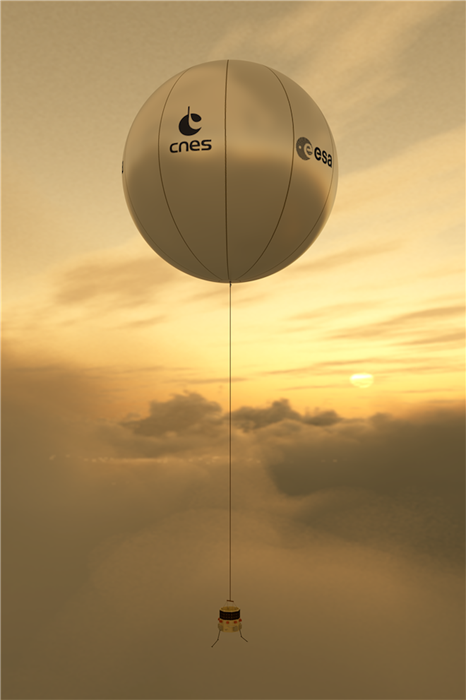.

A concept for the European Venus Explorer balloon seen floating in Venus’ atmosphere. The Soviet Vega missions would have looked similar to this proposed balloon probe. Image: T.Balint / EVE
.
Soviet Balloon Probes May Have Seen Rain on Venus
A pair of balloon probes that floated in the atmosphere of Venus nearly 30 years ago may have run into a drizzle.
This being Earth’s hellish sister planet – where surface pressure is akin to being 900 m underwater and average temperatures are hot enough to melt lead – the shower wasn’t made of friendly water but rather corrosive sulfuric acid. The finding comes from a re-analysis of data taken by the Vega 1 and 2 missions and may represent the first onsite detection of rain ever made outside of Earth.
In 1984, the Soviet Union joined with several European countries to launch the Vega probes, a complex mission that dropped a pair of landers and balloons on Venus and then sent two spacecraft to make close encounters with Halley’s comet in 1986. No other mission has ever deployed balloons on another planet.
The two 3.5-m-diameter balloons floated for nearly two days in the Venusian atmosphere around 55 km above the surface. Unlike the hostile terrain below, the cloud layers at this height are a veritable wonderland. Temperature and pressure are comparable to Earth’s average and there is ample sunlight streaming in from above. If not for the sulfuric acid clouds and hurricane-force winds, the atmosphere of Venus would be a comfortable living space.
Most previous analyses of the mission noted that the balloons slowly leaked helium and descended as they traveled, and that has been considered the end of the story.
But the balloons were well built, made of a Teflon-impregnated material and “it would have been rare for them to start leaking,” said aeronautical engineer Graham Dorrington of the Royal Melbourne Institute of Technology in Australia, author of a paper on this work that appeared Apr. 6 in Advances in Space Research.
Looking again at the old data Dorrington noticed that one of the balloons, from Vega 2, seemed to have reduced its leakage rate at some point, as if it had somehow repaired itself. “I thought that was funny,” he said.
An alternative explanation for why the balloons descended would have been that they got heavier, most likely from a buildup of liquid on their outer surface. Sulfuric acid could have precipitated out of Venus’ clouds in a fine mist, coating the balloons and then slowly dripping off. In the case of the Vega 2 balloon, sensors indicated that at one point the probe’s buoyancy changed quickly, on the order of a minute, which could have happened when the balloon ran into a light drizzling shower.
“This work is credible and interesting, but speculative,” wrote planetary scientist Kevin McGouldrick of the University of Colorado, Boulder, who was not involved in the work, in an email to Wired.
Clouds are made of extremely tiny liquid drops that are suspended in the atmosphere. Rain happens when enough of these drops stick together to form a larger drop and fall from the sky.
While tiny particles of fine mist could conceivably form in the sulfuric acid clouds on Venus, it is an open question whether or not larger rain-like drops could exist, McGouldrick wrote. NASA’s Pioneer Venus spacecraft, which dropped a probe through the Venusian cloud layers and measured their properties in 1978, did not see large sulfuric acid drops during its fall.
But even on Earth, rainstorms are sporadic events, said Dorrington. The odds of a probe dropping through our atmosphere and hitting a downpour aren’t very big, so Pioneer Venus might have missed this evidence. And other spacecraft, like Mariner 10, have seen evidence of rainstorms, though nothing definitive. It will likely take a future mission to the cloud layers of Venus to conclusively confirm or deny the possibility of rain.
If the findings were proven, they would be the first onsite detection of rain on another planet. The European Space Agency’s Huygens probe, which landed on Saturn’s moon Titan in 2005, may have photographed a liquid drop from rain, though whether this came from the moon or the probe isn’t known.
Quelle: WIRED
5552 Views

